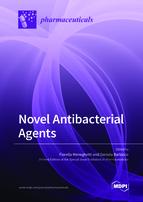Novel Antibacterial Agents
A special issue of Pharmaceuticals (ISSN 1424-8247).
Deadline for manuscript submissions: closed (31 October 2020) | Viewed by 84793
Special Issue Editors
Interests: diffraction techniques; structure elucidation; conformation of bioactive compounds; antitubercular and anticancer agents; metal complexes, protein–protein interaction inhibitors; enzymatic inhibitors; multi-target drugs
Special Issues, Collections and Topics in MDPI journals
Interests: protein–protein interaction inhibitors; enzyme inhibitors; multi-target drugs; anticancer agents
Special Issues, Collections and Topics in MDPI journals
Special Issue Information
Dear Colleagues,
Infectious diseases still account for a substantial proportion of deaths worldwide. The plague of antimicrobial resistance represents an alarming signal for both human and animal healthcare, which drives the search for novel classes of antibiotics to replenish our armamentarium against bacterial infections.There is a great interest in the opportunities and challenges associated with tackling infectious diseases for developing effective and possibly cheap antimicrobial agents endowed with new mechanisms of action. The discovery of new antimicrobials as well as the expansion of utility of existing antibiotics would be crucial to fight the ever-increasing antimicrobial resistance of “superbugs”, pathogenic fungi, viruses, and parasites. Pharmaceuticals invites both reviews and original articles highlighting the recent medicinal chemistry research on novel antibacterial agents. Topics include natural product screening, identification and validation of new antibacterial targets and strategies for the discovery and optimization of antibacterial compounds.
The collection of manuscripts will be published as a Special Issue of the journal.
Dr. Fiorella Meneghetti
Prof. Daniela Barlocco
Guest Editors
Manuscript Submission Information
Manuscripts should be submitted online at www.mdpi.com by registering and logging in to this website. Once you are registered, click here to go to the submission form. Manuscripts can be submitted until the deadline. All submissions that pass pre-check are peer-reviewed. Accepted papers will be published continuously in the journal (as soon as accepted) and will be listed together on the special issue website. Research articles, review articles as well as short communications are invited. For planned papers, a title and short abstract (about 100 words) can be sent to the Editorial Office for announcement on this website.
Submitted manuscripts should not have been published previously, nor be under consideration for publication elsewhere (except conference proceedings papers). All manuscripts are thoroughly refereed through a single-blind peer-review process. A guide for authors and other relevant information for submission of manuscripts is available on the Instructions for Authors page. Pharmaceuticals is an international peer-reviewed open access monthly journal published by MDPI.
Please visit the Instructions for Authors page before submitting a manuscript. The Article Processing Charge (APC) for publication in this open access journal is 2900 CHF (Swiss Francs). Submitted papers should be well formatted and use good English. Authors may use MDPI's English editing service prior to publication or during author revisions.
Keywords
- small molecules
- peptides
- peptidomimetics
- bacterial infections
- fungi
- virus
- parasites
- drug design
- computational tools
- biology assays
- resistance mechanisms.
Related Special Issues
- Small Molecules as Antimicrobials in Pharmaceuticals (16 articles)
- Antibiotics in Pharmaceuticals (10 articles)
- Antimicrobial Agents in Pharmaceuticals (6 articles)
- Bacterial Drug Persisters: Basis, Regulatory Events, and Role in Pathogenesis in Pharmaceuticals (1 article)







